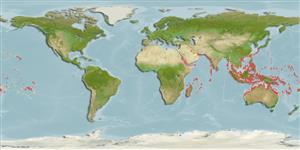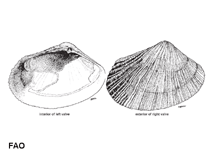Asaphis violascens (Forsskål, 1775)
Pacific asaphis| Native range | All suitable habitat | Point map | Year 2050 |

|
| This map was computer-generated and has not yet been reviewed. |
| Asaphis violascens AquaMaps Data sources: GBIF OBIS |
Classification / Names Common names | Synonyms | CoL | ITIS | WoRMS
Bivalvia | Cardiida | Psammobiidae
Environment: milieu / climate zone / depth range / distribution range Ecology
Benthic; brackish; depth range 0 - 20 m (Ref. 348). Tropical; 31°N - 33°S, 30°E - 137°W
Distribution Countries | FAO areas | Ecosystems | Occurrences | Introductions
Indo-Pacific: from East Africa, including Madagascar, the Red Sea, Persian Gulf and Andaman Sea, to eastern Polynesia; north to Japan and south to central Queensland and New Caledonia.
Length at first maturity / Size / Weight / Age
Maturity: Lm 2.5 range ? - ? cm Max length : 11.0 cm SHL male/unsexed; (Ref. 348); common length : 6.5 cm SHL male/unsexed; (Ref. 348)
Average edible weight is at 9 g (Ref. 351). Maximum depth from Ref. 75831. Littoral and sublittoral to a depth of about 20 m (Ref. 345). Found in intertidal areas in sand (Ref 75831). Deeply buried in sand, often coarse to gravel bottoms (Refs. 345, 126564). In general, suspension feeding bivalves mainly depend on phytoplankton and detritus material for nutrition (Ref. 107088).
Life cycle and mating behavior Maturity | Reproduction | Spawning | Eggs | Fecundity | Larvae
Mass spawning occurs in late summer and larval stage is about 14 days (Ref. 351).
Main reference
References | Coordinator | Collaborators
Poutiers, J.M. 1998. (Ref. 348)
IUCN Red List Status (Ref. 130435)
CITES status (Ref. 108899)
Not Evaluated
CMS (Ref. 116361)
Not Evaluated
Threat to humans
Harmless
Human uses
Fisheries: commercial
| FishSource | Sea Around Us
Tools
More information
Internet sources
BHL | BOLD Systems | CISTI | DiscoverLife | FAO(Publication : search) | Fishipedia | GenBank (genome, nucleotide) | GloBI | Gomexsi | Google Books | Google Scholar | Google | PubMed | Tree of Life | Wikipedia (Go, Search) | Zoological Record
Estimates based on models
Preferred temperature
(Ref. 115969): 25 - 29.3, mean 28.4 (based on 3504 cells).
Price category
(Ref. 80766):
Unknown.
Nutrients: Calcium = 149 [71, 228] mg/100g; Iron = 8.53 [1.95, 15.11] mg/100g; Protein = 9.88 [8.64, 11.12] %; Omega3 = 0.313 [0.202, 0.423] g/100g; Selenium = 61 [50, 72] μg/100g; VitaminA = 0 μg/100g; Zinc = 2.04 [0.56, 3.51] mg/100g (wet weight).



